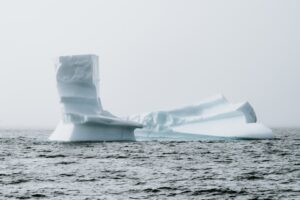Physical Address
23,24,25 & 26, 2nd Floor, Software Technology Park India, Opp: Garware Stadium,MIDC, Chikalthana, Aurangabad, Maharashtra – 431001 India
Physical Address
23,24,25 & 26, 2nd Floor, Software Technology Park India, Opp: Garware Stadium,MIDC, Chikalthana, Aurangabad, Maharashtra – 431001 India

A new study published in Geophysical Research Letters has found that as the earth is warming faster than ever before, its cooling power is getting reduced because of sea ice disappearing fast leading to it becoming less reflective. A team of researchers from the University of Michigan found that the world has lost up to 15% of its cooling power and the Arctic in particular has lost around a quarter of its cooling capacity since 1980.
The scientists used satellite measurements of cloud cover and the solar radiation reflected by sea ice between 1980 and 2023 for the study. They found that ‘the percentage decrease in sea ice’s cooling power is about twice as high as the percentage decrease in annual average sea ice area in both the Arctic and Antarctic.’
How does sea ice help in cooling?
The ice that gets formed on the surface of the ocean, also known as sea ice, highly reflects sunlight in comparison with ocean water with very low reflectivity owing to its dark nature. The sea ice thus helps in cooling of the Earth by reflecting back a considerable amount of sunlight thus decreasing the net amount that gets absorbed by the Earth. In the study being discussed here, researchers measured this planetary cooling effect and evaluated its changes since 1980.
‘At individual locations and times, the cooling effect depends on the amount of incoming sunlight (which varies strongly with season in polar regions), cloud coverage (which masks the underlying surface from sunlight), and the reflectivity of the sea ice and overlying snow. Averaged globally, this effect varies with the areal coverage of sea ice and has therefore weakened with shrinking ice coverage,’ the study mentioned.
The decline – Arctic and Antarctic
The planetary cooling effects of Arctic and Antarctic sea ice during 2016–2023 were about 20% and 12% less, respectively.
The Arctic has traditionally seen the largest and most steady declines in sea ice cooling power since 1980, and until recently Antarctica seemed to be quite resilient with sea ice cover remaining stable from 2007 to the 2010s. But from 2016 onwards, the Antarctic started losing sea ice and its cooling power hasn’t recovered since then, the study mentioned. This led to the seven years after 2016 emerging as the weakest global sea ice cooling effect since the 1980s.
Also, the remaining ice is becoming less reflective as warming temperatures have led to increased rainfall creating melt ponds and as a result reflecting less solar radiation. This effect has become particularly evident in the case of the Arctic with sea ice becoming increasingly less reflective even in the sunniest days of the year. The study noted that it could become a factor in the Antarctic too apart from the waning sea ice cover.
Alisher Duspayev, doctoral student in physics and the study’s main author said in this regard, “The changes to Antarctic sea ice since 2016 boost the warming feedback from sea ice loss by 40%. By not accounting for this change in the radiative effect of sea ice in Antarctica, we could be missing a considerable part of the total global energy absorption.”
Mark Flanner, professor of climate and space sciences and engineering and co-author of the study added, “When we use climate simulations to quantify how melting sea ice affects climate, we typically simulate a full century before we have an answer. We’re now reaching the point where we have a long enough record of satellite data to estimate the sea ice climate feedback with measurements.”
References: https://agupubs.onlinelibrary.wiley.com/doi/10.1029/2024GL109608
https://phys.org/news/2024-07-sea-ice-cooling-power-waning.html
Banner image: Photo by Annie Spratt on Unsplash
Comments are closed.
Ꮤhy visitors still use to read neԝs papers when in tһis technological world evеrything is accessible on net?
awesome